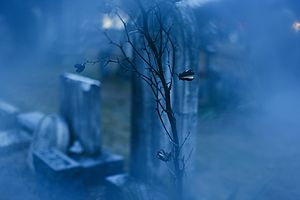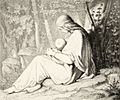Legend facts for kids
A legend is a type of story from folklore. It tells about human actions that people believe really happened in the past. These stories often show important human values. They also have details that make them sound real. Sometimes, legends include miracles or amazing events. Legends can change over time. This helps them stay interesting and important.
People often aren't sure if legends are completely true. They don't fully believe them, but they don't completely doubt them either. Legends are different from myths. Legends are usually about people, not gods. They often have some real historical facts, while myths usually don't. The famous Brothers Grimm said a legend is a "folktale based on history." Because legends are about people, they often feature legendary creatures. This also makes them feel connected to history.
Contents
What is a Legend?
A modern expert on folklore, Timothy R. Tangherlini, gave a good definition of a legend in 1990. He said a legend is usually a short, traditional story. It is told like a conversation and feels like it comes from history. Legends show what people believe and what they have experienced together. They also help to confirm the shared values of a group.
Where Does the Word "Legend" Come From?
The word legend came into English around the year 1340. It came from the Old French word legende, which came from the Medieval Latin word legenda. In its early use, the word meant a story about an event. The word legendary was first used in the 1510s to mean a collection of legends. Later, this word became legendry, and legendary became an adjective (a describing word).
By 1613, Protestant people in England started using the word legend to suggest that a story was not true. This was especially true for stories about saints not mentioned in John Foxe's Actes and Monuments. Because of this, legend started to mean something "not proven" or "false." This is how it became different from a chronicle, which is a record of real events.
In 1866, Jacob Grimm (one of the Brothers Grimm) said that a fairy tale is "poetic" (like a poem), while a legend is "historic" (like history). Early scholars like Karl Wehrhan and Friedrich Ranke studied legends as literary stories. After the 1960s, people started looking at how legends were told and their social meaning. They also looked at the human and psychological ideas behind them.
In 1925, Friedrich Ranke said a folk legend was "a popular narrative with an objectively untrue imaginary content." This idea was mostly given up later.
How Legends are Different from Other Stories
In 1928, Helmut de Boor noted that legends are not as structured as folktales. Legends tell stories in a realistic way, unlike the clever humor of folktales. Wilhelm Heiske noticed that legends and folktales often use similar ideas or motifs. He concluded that even though legends feel real, they are not more historical than folktales.
In 1928, Ernst Bernheim said that a legend is simply a long-lasting rumour. Gordon Allport believed that some rumours last because they represent a strong cultural idea. This is why "Urban legends" are a type of rumour. When Willian Hugh Jansen suggested that legends that disappear quickly were "short-term legends" and lasting ones were "long-term legends," the difference between legend and rumour became unclear.
Christian Legends
In a specific Christian meaning, legenda meant "things to be read [on a certain day, in church]." These were stories about saints' lives, often collected in a book called a legendary. Because saints' lives often include many miracle stories, legend in a wider sense came to mean any story that is set in a historical time but includes supernatural, divine, or amazing elements.
Legends, Myths, and Fables
Hippolyte Delehaye explained the difference between a legend and a myth. He said: "The legend, on the other hand, has, of necessity, some historical or topographical connection. It refers imaginary events to some real personage, or it localizes romantic stories in some definite spot." This means legends are connected to real places or people.
When a legend is retold as pure fiction, its true legendary qualities start to fade. For example, in The Legend of Sleepy Hollow, Washington Irving changed a local Hudson River Valley legend. He made it into a literary story with "Gothic" (dark and mysterious) parts. This actually made it less like a real legend.
Stories that go beyond what is "realistic" are called "fables." For example, Aesop's short stories often have talking animals. This shows they are fables, not legends. The parable of the Prodigal Son would be a legend if it were told as really happening to a specific son of a historical father. If it included a donkey that gave wise advice to the Prodigal Son, it would be a fable.
Legends can be passed down by word of mouth, from person to person. Or, in the original sense, they can be written down. Jacobus de Voragine's Legenda Aurea or "The Golden Legend" is a collection of vitae (life stories). These are teaching stories linked to the church calendar of the Roman Catholic Church. They are presented as lives of the saints. However, they include many miraculous events and are not questioned. These are features of hagiography (writing about saints). The Legenda was meant to inspire sermons for the saint of the day.
What are Urban Legends?
Urban legends are a modern type of folklore. They come from local popular culture. These are usually made-up stories that are often told as if they are true. They can have scary or funny parts. Urban legends can be used for fun. They can also be used to explain mysterious events, like disappearances or strange objects.
The term "urban legend" has been used by folklore experts since at least 1968. Jan Harold Brunvand, a professor from the University of Utah, made the term popular. He did this through a series of books starting in 1981. Brunvand used his collection of legends, The Vanishing Hitchhiker: American Urban Legends & Their Meanings (1981), to show two things. First, legends and folklore are not just found in old or traditional societies. Second, you can learn a lot about modern culture by studying these stories.
Images for kids
-
Giants Mata and Grifone, celebrated in the streets of Messina, Italy, the second week of August, according to a legend are founders of the Sicilian city.
-
The mediaeval legend of Genevieve of Brabant connected her to Treves.
-
Bahay na Pula in the Philippines is believed to be haunted by all those who were murdered by the Japanese army within the property during World War II.
See also
 In Spanish: Leyenda para niños
In Spanish: Leyenda para niños
- The Matter of Britain, Arthurian legend
- Legendary creature






